Final report for FNC06-615
Project Information
PROJECT BACKGROUND
I work for a family farm. We farm 8500 acres and run 750 head of cows in a cow calf operation.
We raise winter wheat, spring wheat, soybeans, corn, sunflowers, field peas, alfalfa, lentils and millet.
We have been 100% no-till for 18 years. This is truly a farming family. The farm is on its 100th birthday this year and we are still going strong.
I have been a part of this farm for 42 years and have a deep love and respect for the land.
We have been in no-till for 18 years. We have been trying cover crops to promote soil health.
PROJECT DESCRIPTION AND RESULTS
Goals. Determine:
1. The amount of moisture cover crops used.
2. The amount of carbon certain cover crops sequester.
3. How much nitrogen you gained from different mixes of cover crops.
4. The weed suppression from different cover crops mixes.
5. The yield you can get with no nitrogen with the different cover crop mixes.
6. The yield you can get with nitrogen and cover crop mixes.
7. The increase in protein in the grain with the different cover crops mixes.
8. The amount of biomass from different cover crop mixes.
Process:
1. We soil sampled in 8/7/2007 for nitrate, phosphorus, and soil moisture. (We wanted to see where these levels were before planting cover crops.)
2. We planted 8 different cover crop mixes and one strip of no cover crop and replicated this 3 times. Our plot covered 57 acres. (We needed to know the right cover crops to plant and if cover crop mixes worked.)
3. We left nitrogen-free strips in each plot for testing and hand harvest. (We had to find out how the different cover crops helped us with our yields without using additional nitrogen.)
4. We soil sampled 10/25/2007 for nitrate and moisture. We also checked each replication for biomass weight. (We found out from this soil sample how much nitrogen was fixed with the legumes. Also how much moisture each cover crop used. It was put up against the plots with no cover crop.)
5. We planted corn 5/8/2008 and soil sampled for moisture and nitrates. (We wanted to know how much moisture the cover crops used. To see if any of the nitrogen leached.)
6. We took biomass of the corn plant at V6 and R1. (To see how the different cover crops helped with increasing biomass.)
7. We hand harvested so many feet of the nitrogen fed cover crop strips and also so many feet of the nitrogen-free strips. (We needed to see how the strips with nitrogen and without compared in yield and protein. We also compared these with the strips with no cover crops.)
8. We harvested the whole plot with our combine and weighed each plot. (We wanted to see how the whole plot yield compared to the hand harvested yield.)
9. We will soil sample again 5/6/2009 to see if some strips have more carry over nitrogen than others. (We need to know how much nitrogen is left in the spring. There might be some benefit for next year’s crops on different cover crop mixes. The plots that had higher protein might have more nitrates. We have to find out.)
PEOPLE
• USDA-ARS (Dr. Shannon Osborn) She helped set the plot up and showed me the direction that we should go. She helped with the sampling analysis. Helped with the soil samples and biomass samples. She spoke at our field day.
• Dakota Lakes (Dr. Dwayne Beck) helped me pick the cover crops that we needed to look at. Brought a lot of attention to our grant. He talks all over the world and has contact with a lot of people. A great promoter of the plot. He spoke at our field day.
• SDSU Extension (Ruth Beck – Terry Hall) helped take pictures every two weeks and also with collecting soil samples and biomass samples. They helped GPS the sample point in the plots. A great help getting the word out about the plot and setting up our field day. It was great.
• NRCS (Jason Miller) helped picking out cover crops and had a separate field day for the state NRCS people. This helped bring attention outside our area. He spoke at our field day.
• Mike Cronin, farmer, helped mix the cover crop and plant the plots.
•Shane Stevens, farmer, helped with harvest.
RESULTS
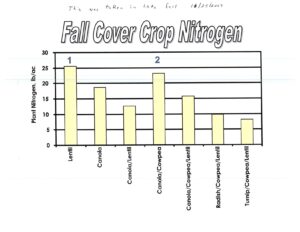
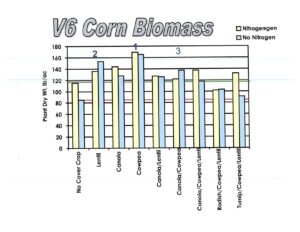
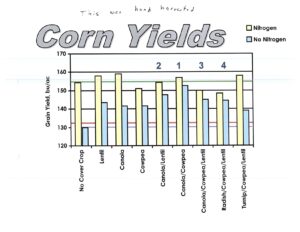
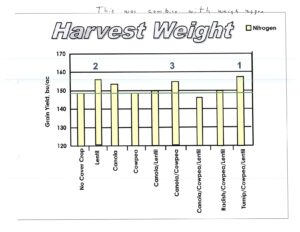
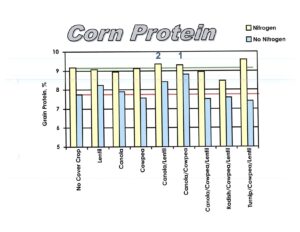
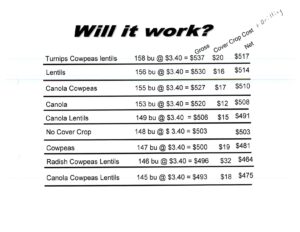
• With certain cover crops we increased yield and net per acre.
• I spoke of this grant a lot. I speak at no-till conferences in the Midwest and every time since my grant I have spoke of it. I kept telling people, we will get answers. I was right, it was great.
I would like to try different cover crop mixes. I think this is the future in building soil health.
DISCUSSION
What we learned:
• The cost effectiveness of cover crops over no cover crops. We can use cover crops to improve yield without using so much man-made nitrogen.
• It has showed us the way to better use cover crops.
• Yes this was a good project with a lot of answers. It was set up and replicated the right way. This was great answer plot.
• It takes a lot of work. This is a new system in our area and there are a lot of skeptics. This helped make believers out of a lot of people.
• I talk to farmers and ranchers every day. I have helped everyone that has asked for help and will keep on doing this. I put my heart and soul in this project and I truly believe if you take care of the land it will take care of you.
OUTREACH
I spoke at these conferences:
• No-Till on the Plains, Salina, KS, 1,200 people
• Gettysburg, SD, FSA student, 45 people
• UMAC Grand Fords, ND, 65 people
• Gettysburg Rotary, 35 people
• Ranchers workshop SDSU, 120 people
• Ag Horizon, Pierre, SD, 85 people
• Cover Crop Clinic, Huron, SD, 300 people
• Rancher Workshop, Gettysburg, SD, 90 people
• Emmons County No-Till, Linton, ND, 125 people
• Farmers Forum, Northern Plains Sustainable Agriculture Society (NPSAS) Winter Conference, Huron, SD, 35 people
I will send pictures. This was in several papers but I did not save the clippings.
Our field day was on the radio with the mention of the SARE grant.
* We had Gettysburg FFA at a field day, 25 people
* NRCS field day, 40 people
* SARE Grant field day, 70 people
I talked to Gettysburg Rotary in March 2008 about the SARE grant and the benefits of cover crops. I will talk about the results of the grant in March of 2009.
VIDEO
SARE has formed a unique partnership with Cooking Up A Story, an online television show about people, food, and sustainable living. Our partnership will enable us to expand the range and depth of their stories and how-to videos, and to profile successful farmers whose practices have benefited from SARE grants and SARE research to improve their own economic viability, and stewardship of the land. NCR-SARE features have included Dan Forgey.
• http://cookingupastory.com/the-next-step-adding-cover-crop-to-a-no-till-system-2
• http://cookingupastory.com/no-till-farmer-steward-of-the-land
• http://cookingupastory.com/south-dakota-farmer-uses-no-till-and-cover-crops-practices-to-improve-yields
• http://cookingupastory.com/growing-cover-crop-with-a-cash-crop